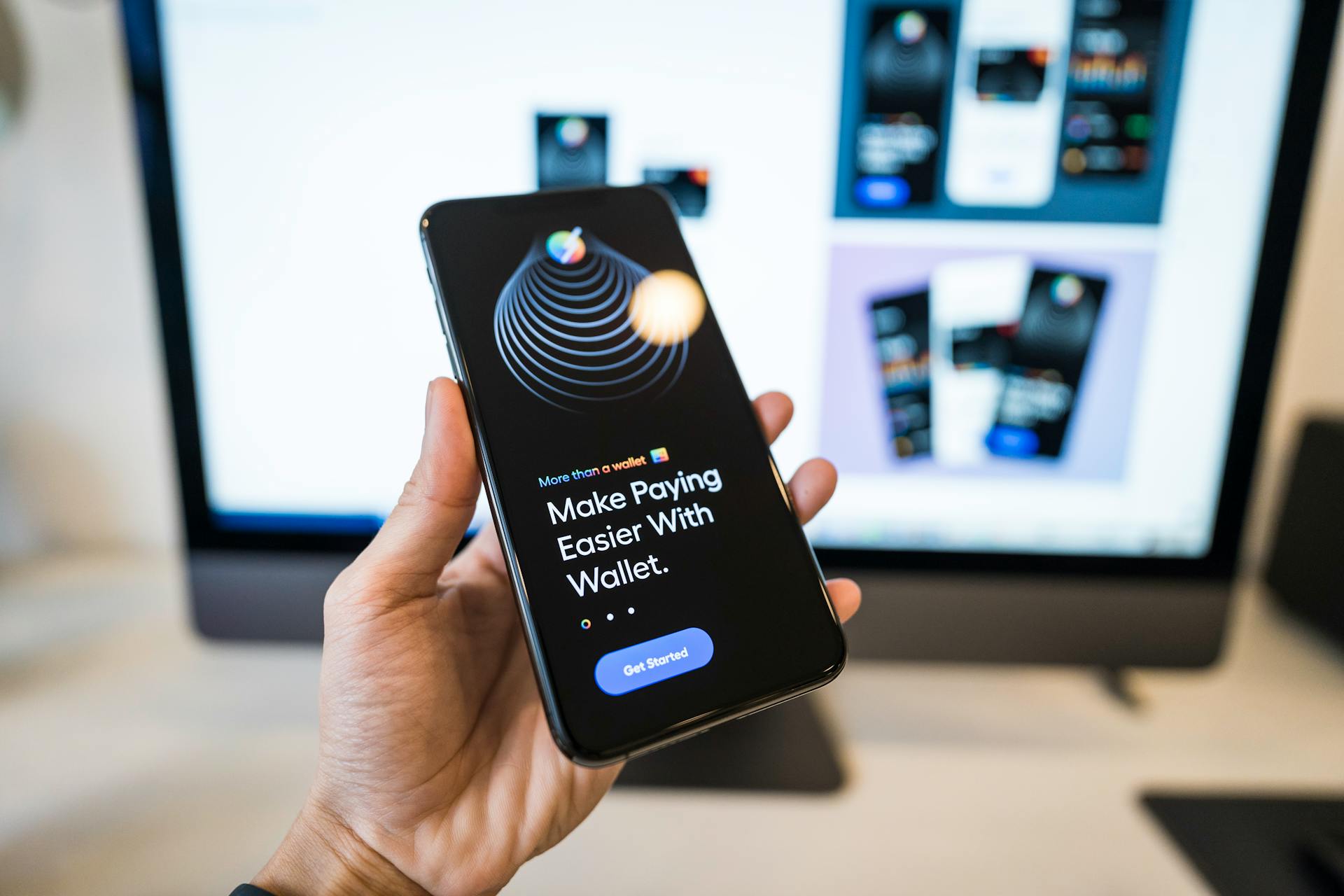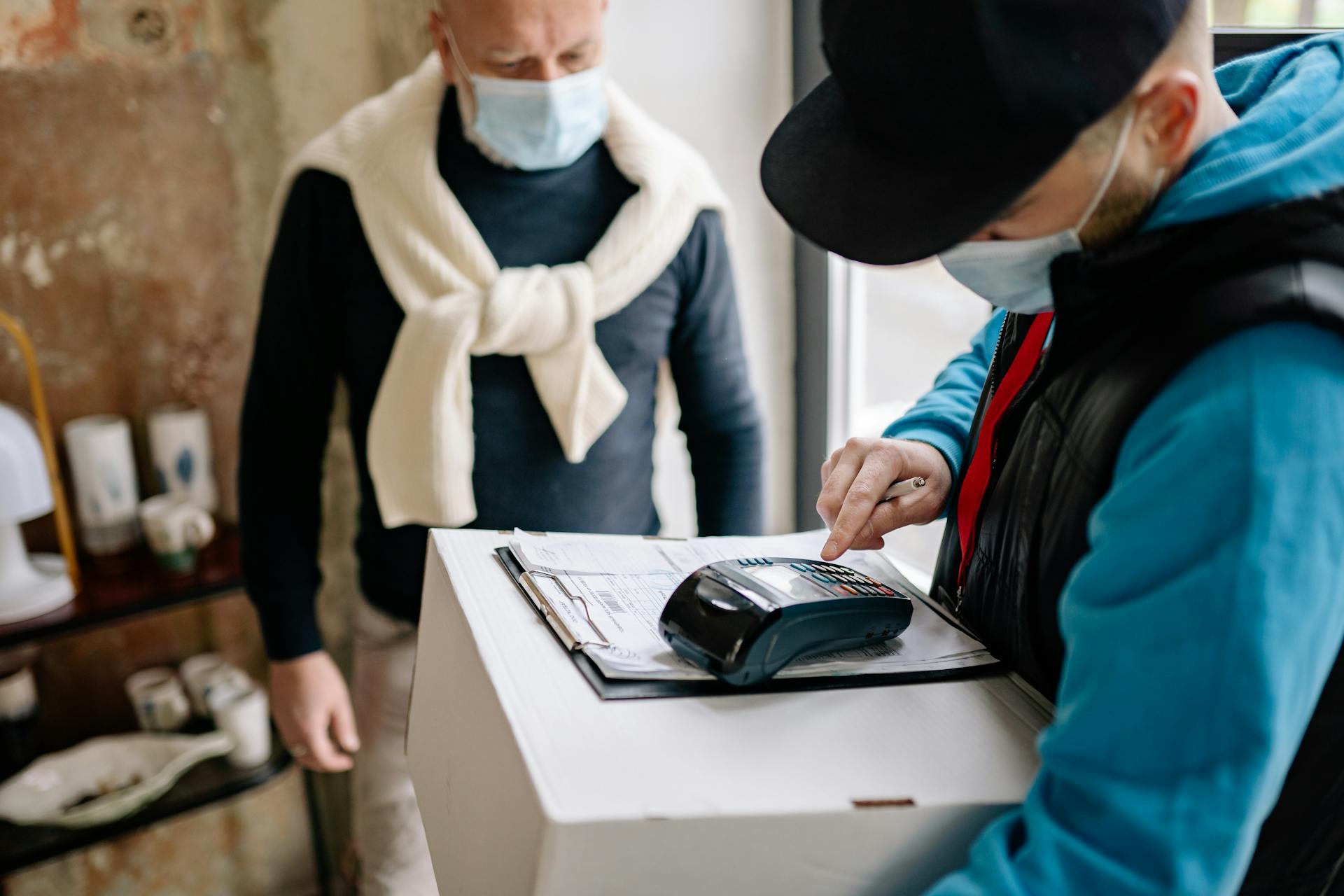
Setting up a mobile wallet in China as a foreigner can be a bit daunting, but don't worry, we've got you covered.
First, you'll need a Chinese bank account to link to your mobile wallet. This is because most Chinese mobile wallets require a local bank account to function.
You can open a Chinese bank account at a local bank or online, and some banks even offer accounts specifically designed for foreigners.
To get started, you'll need to gather the necessary documents, such as your passport and proof of address, which can be a hotel bill or a utility bill.
Check this out: Notable Chinese Banks
Setting Up Mobile Wallet in China
To set up a mobile wallet in China, you'll need to link your international credit or debit card to the WeChat Pay or Alipay platform. This can be done by adding your card details to the app, which supports Visa, Mastercard, JCB, and Discover Global Network cards.
You can register for WeChat Pay or Alipay using your phone number, and then bind your bank card to make purchases and enjoy other convenient services. Alipay also allows you to register with a foreign mobile phone number.
To add your bank card, you can do it directly on the home page when registering for the first time, or by tapping the "Account" section and then "Bank Cards" in the app. Please note that Alipay supports Visa, Mastercard, Diners Club, Discover, and JCB cards.
Here's a summary of the supported cards for easy reference:
Before signing up for WeChat Pay or Alipay, make sure you can receive SMS verification codes, and note that identity verification must be carried out in China.
Quick Setup
To set up a mobile wallet in China, start by downloading the Alipay APP on your mobile phone. You can download or update your Alipay APP to the latest version.
Next, familiarize yourself with the Alipay APP's interface and features. The Alipay APP is user-friendly and easy to navigate, making it a great choice for beginners.
To begin using Alipay, you'll need to create an account if you don't already have one. Simply follow the prompts to register and verify your account.
Once you have your account set up, you can start making payments and transactions. The Alipay APP allows you to make payments with just a few taps on your screen.
Required Documents
To set up a WeChat Pay account, you'll need to have one of six specific documents. These include a passport, foreign permanent resident ID card, mainland travel permit for Hong Kong and Macao residents, mainland travel permit for Taiwan residents, residence permit for Hong Kong and Macao residents, and residence permit for Taiwan residents.
You can use any of these documents to register for WeChat Pay, and they're all accepted for the registration process.
See what others are reading: How to Pay with Wechat
Before Signing Up
To use mobile wallets like Alipay and WeChat Pay in China, you'll need to sign up first. This involves providing some essential information and documents.
Make sure you can receive SMS verification codes, which will be sent to you when you create your account. If you can't receive these codes, you may need to obtain a Chinese SIM card.
It's also possible to register from abroad, but you'll need to complete identity verification in China. This is because the face scan function isn't available in some countries.
Here are the required documents for setting up WeChat Pay:
- Passport
- Foreign Permanent Resident ID Card
- Mainland Travel Permit for Hong Kong and Macao Residents
- Mainland Travel Permit for Taiwan Residents
- Residence Permit for Hong Kong and Macao Residents
- Residence Permit for Taiwan Residents
WeChat Pay Setup
To set up WeChat Pay, you'll need to link your international credit or debit card to the platform. This can be done by opening the WeChat app and going to the "Me" section.
You can link your foreign cards to WeChat Pay by following these simple steps: update your app to the latest version, open WeChat and go to the "Me" section, tap on "Wallet" to access your payment options, click on "Bank Card" and choose "Add a New Bank Card."
Recommended read: Can You Link Credit Cards to Cash App
Here are the required documents for setting up WeChat Pay: Passport, Foreign Permanent Resident ID Card, Mainland Travel Permit for Hong Kong and Macao Residents, Mainland Travel Permit for Taiwan Residents, Residence Permit for Hong Kong and Macao Residents, and Residence Permit for Taiwan Residents.
To bind your foreign cards, you'll need to enter the card number, select the type of card, and the issuing organization, and fill in the required card and personal information. A confirmation message will appear when the binding is successful.
During the card binding process, make sure your mobile phone number is capable of receiving SMS verification codes. This number does not have to be a mainland China mobile number, but can be a foreign number.
Once you've completed the verification process, create a 6-digit payment password to ensure the security of your WeChat Pay account.
Curious to learn more? Check out: Is Pci Compliance Mandatory
Payment Options and Fees
You can link your overseas bank cards to your Alipay account, allowing you to make payments within the Chinese mainland.
Transactions under ¥200 are free, but a 3% transaction fee is charged for each transaction above ¥200. This fee is waived if you request a refund for a transaction.
WeChat Pay also supports overseas bank cards, and their international card service is quite similar to Alipay's. However, WeChat Pay allows a maximum of RMB 6,000 per single transaction, whereas Alipay allows up to RMB 3,000.
Both Alipay and WeChat Pay have transaction limits, so it's essential to be aware of these limits when making payments.
On a similar theme: E S a Payments
Adding Overseas Bank Cards
Adding overseas bank cards to your mobile wallet in China is a straightforward process. You can add foreign cards to WeChat Pay by following simple steps, which include updating the app, accessing the "Me" section, and tapping on "Wallet" to add a new bank card.
To ensure a smooth binding process, make sure your phone number can receive SMS verification codes, and it doesn't have to be a Chinese number. You'll also need to create a 6-digit payment password for security.
See what others are reading: Why Do Banks Take so Long to Process Payments
WeChat Pay supports various international card types, including JCB cards, which Alipay does not offer. However, Alipay has its own international card service, which is similar to WeChat Pay in terms of usage scenarios and transaction fees.
To add an overseas bank card to Alipay, you'll need a major international credit card, such as Visa, Mastercard, or Diners Club. You can register for Alipay with your foreign phone number and bind it to a supported bank card.
Here's a summary of the transaction limits for foreign cards on WeChat Pay and Alipay:
Remember, foreign cards on WeChat Pay don't support features like red packets or direct transfers, but they do allow daily consumption transactions.
Mobile Payments in China
Mobile payments in China have become incredibly convenient, especially with the rise of cashless societies. The country's mobile payment market is expected to reach a value of US$37.15 trillion by the end of 2023, with an annual growth rate of 8.38 percent.
QR codes have played a pivotal role in facilitating fast and convenient mobile payments. You can find them at various shops and establishments across the country, making it easy to adopt digital payment methods.
Major players like Alibaba and Tencent have introduced AliPay and WeChat Pay, which have emerged as powerful entry points to vast ecosystems of both offline and online goods and services. These digital payment platforms provide users with seamless and convenient payment experiences.
To use WeChat Pay, foreign users can link their international credit or debit cards to the WeChat Pay platform. Once the cards are successfully linked, they can use WeChat Pay to make payments to merchants across various sectors, including dining, shopping, transportation, and hotel accommodation.
The majority of vendors and businesses in China prefer to be paid by Alipay and WeChat Pay rather than in cash. This means you'll likely encounter fewer cash-only establishments, especially in major cities like Shanghai, Beijing, Shenzhen, and Guangzhou.
Here are the supported international cards for WeChat Pay:
- Visa
- Mastercard
- JCB
- Discover Global Network
Since August 2023, foreigners can register for Alipay or WeChat Pay with a non-Chinese telephone number, foreign passport details, and an international bank card. This makes it easier for non-resident foreigners to make payments in China.
Transactions related to wealth management or transfers are not supported when using overseas bank cards with Alipay. However, you can add overseas bank cards to your Alipay account and pay for daily purchases within the Chinese mainland.
Intriguing read: One - Mobile Banking
Practical Guide
To set up a mobile wallet in China, you'll need to download the app and sign up for the international version, which is a straightforward process. For example, with Alipay, you can download the application and sign up for the international version by following the prompts.
You'll also need to add your bank account to the app, which is a simple process that the application will guide you through. With WeChatPay, you can install WeChat on your phone and register with your phone number or log in if you already have an account.
To start using your mobile wallet, you'll need to add a payment method, such as a credit or debit card. With WeChatPay, you can enter your details and add a card by going to the Wallet tab and then pressing "add a card".
Broaden your view: Tap to Pay Sign
Practical Installation Guide
So you're looking to install and set up Alipay and WeChat Pay on your phone? First, download the Alipay application and sign up for the international version. To add a bank account, press "add now" and let the application guide you through the registration process.
A fresh viewpoint: Bbva Bank Application

To install WeChat Pay, install WeChat on your phone and register with your phone number or log in. Make sure you have the latest version, update if necessary. To activate Weixin Pay, click on "Me" – "Service" then "Wallet" in the application. Alternatively, you can activate it by clicking on "Me" – settings – general – tools – weixin pay at the bottom of the screen.
To add a card to Weixin Pay, go to the Wallet tab and press "add a card". You will need to accept the terms of use and follow the steps to complete the identity details. If you're using a passport, you'll receive a notification prompting you to upload a copy of your ID to the app.
What Can You Do?
With Alipay, you can make purchases in physical stores, take buses, ride the subway, hail taxis, and even bike around.
You can also use Alipay to book hotels, plane tickets, train tickets, and tickets to tourist attractions.
Translation and currency conversion tools are also available to help you navigate China.
Customer service is supported in multiple languages, including English, to assist with any issues that may arise.
Sources
- https://www.registrationchina.com/articles/how-to-use-alipay-app-to-help-foreigner-visiting-china/
- https://www.china-briefing.com/news/wechat-enables-foreigners-to-pay-with-overseas-cards-in-china/
- https://english.shanghai.gov.cn/en-BankingServices/20231215/fe3a293d065f40e0a7f740aa88edb050.html
- https://www.vvrinternational.com/en/how-do-you-pay-for-your-purchases-when-travelling-in-china-the-guide-by-vvr-international/
- https://www.topchinatravel.com/customer-center/how-to-use-alipay-correctly-in-china-for-foreigners.htm
Featured Images: pexels.com


